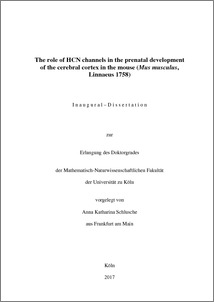Schlusche, Anna Katharina
(2016).
The role of HCN channels in the prenatal development of the cerebral cortex in the mouse (Mus musculus, Linnaeus 1758).
PhD thesis, Universität zu Köln.

![[img]](https://kups.ub.uni-koeln.de/style/images/fileicons/application_pdf.png)  Preview |
|
PDF
Doktorarbeit-Schlusche.pdf
- Accepted Version
Download (8MB)
|
Abstract
The development of the brain requires a complex sequence of processes, and any disturbances in these processes can lead to severe disorders such as lissencephaly and microcephaly.
The involved events, like the proliferation of neural stem and progenitor cells, the differentiation into a variety of neuronal and glial subtypes, as well as the migration of differentiated cells to their final localization, are tightly regulated. Among other mechanisms, the electrical activity of the brain, which is determined by extrinsic and intrinsic properties of neurons and glia, contributes to the spatial and temporal control of these processes.
The hyperpolarization-activated, cyclic nucleotide-gated (HCN) channels and its mediated current Ih, have important functions in modulating the intrinsic biophysical properties of many cell types, including neurons.
This work presents the first investigation of the endogenous subtype expression of HCN subunits in the embryonic forebrain, demonstrating an expression of HCN3 and HCN4 during embryonic development.
To study the functional significance of the early embryonic expression of HCN subunits, Ih was inhibited by a dominant-negative HCN (HCN-DN) subunit, resulting in a subunit-unspecific ablation of the current. Forebrain-specific embryonic expression of the transgenic subunit resulted in a severe microcephaly phenotype. The investigation of early cortical developmental processes revealed an impaired proliferation and differentiation of neural stem and progenitor cells in HCN-DN-expressing transgenic mice, but no impaired migration.
In agreement with these findings, in vitro experiments using primary neural stem cells from the embryonic rat cortex showed a reduced proliferation and altered differentiation when Ih was pharmacologically blocked.
In summary, this is the first work to show an involvement of the HCN3 and/or HCN4 subtypes in the proliferation and differentiation of neural stem and progenitor cells in the mammalian cerebral cortex.
| Item Type: |
Thesis
(PhD thesis)
|
| Translated title: |
| Title | Language |
|---|
| Die Rolle von HCN-Kanälen in der pränatalen kortikalen Entwicklung der Maus (Mus musculus, Linnaeus 1758) | German |
|
| Translated abstract: |
| Abstract | Language |
|---|
| Die Entwicklung des Gehirns folgt einem komplexen Muster, dessen Störung zu einem heterogenen Spektrum an humanen Erkrankungen, inklusive der Lissenenzephalie oder Mikrozephalie, führen kann.
Grundlegende Prozesse der kortikalen Entwicklung sind die Proliferation der neuralen Stamm- und Vorläuferzellen, deren Differenzierung in die verschiedenen neuronalen und glialen Subtypen, sowie die Migration der differenzierten Zellen zu ihren finalen Ziellokalisationen. Diese Vorgänge werden unter anderem durch die elektrische Aktivität des Gehirns reguliert, welche wiederum durch die intrinsischen und extrinsischen Eigenschaften der einzelnen Zellen determiniert wird.
Ein Modulator der intrinsischen biophysikalischen Eigenschaften der Zelle ist der Hyperpolarisations-aktivierte, zyklisch Nukleotid-modulierte (HCN) Kanal und der durch ihn vermittelte Ionenstrom, Ih.
In der vorliegenden Arbeit wurden erstmalig die Expressionsprofile der verschiedenen HCN-Untereinheiten während der embryonalen Vorderhirnentwicklung in der Maus analysiert. Diese Analysen zeigte eine Expression der HCN3- und HCN4-Subtypen im embryonalen Gehirn.
Mittels Expression einer dominant-negativen HCN Untereinheit konnte eine Untereinheiten-unspezifische Ablation des Ih erzielt und damit seine Funktion in der embryonalen Entwicklung untersucht werden. Die embryonale Ablation des Ih führte zu einer Mikrozephalie, die durch eine starke Verringerung der Proliferation und zeitlich veränderter Differenzierung der neuralen Stamm- und Vorläuferzellen verursacht wurde. Die Migration der Neurone war nicht beeinträchtigt.
In vitro Experimenten mit primären kortikalen Stammzellkulturen zeigten ebenfalls eine reduzierte Proliferation und veränderte Differenzierung als Folge der pharmakologischen Inhibition des Ih.
Zusammenfassend zeigt diese Arbeit damit erstmalig eine entscheidende Rolle der HCN-Kanäle und des durch sie vermittelten Ih in der Proliferation und Differenzierung von neuralen Stamm- und Vorläuferzellen. | German |
|
| Creators: |
| Creators | Email | ORCID | ORCID Put Code |
|---|
| Schlusche, Anna Katharina | anna.schlusche@uk-koeln.de | UNSPECIFIED | UNSPECIFIED |
|
| URN: |
urn:nbn:de:hbz:38-71522 |
| Date: |
10 October 2016 |
| Language: |
English |
| Faculty: |
Faculty of Mathematics and Natural Sciences |
| Divisions: |
Faculty of Mathematics and Natural Sciences > Department of Chemistry > Institute of Biochemistry |
| Subjects: |
Life sciences |
| Uncontrolled Keywords: |
| Keywords | Language |
|---|
| Mikrozephalie, HCN Kanal, Gehirnentwicklung, Proliferation, Differenzierung, neurale Vorläuferzellen, biophysikalische Eigenschaften, in utero Elektroporation | German | | Microcephaly, HCN channel, brain development, proliferation, differentiation, neural precursor cells, biophysical properties, in utero electroporation | English |
|
| Date of oral exam: |
7 December 2016 |
| Referee: |
| Name | Academic Title |
|---|
| Kaupp, Ulrich Benjamin | Prof. Dr. | | Paulsson, Mats | Prof. Dr. |
|
| Refereed: |
Yes |
| URI: |
http://kups.ub.uni-koeln.de/id/eprint/7152 |
Downloads per month over past year
Export
Actions (login required)
 |
View Item |


